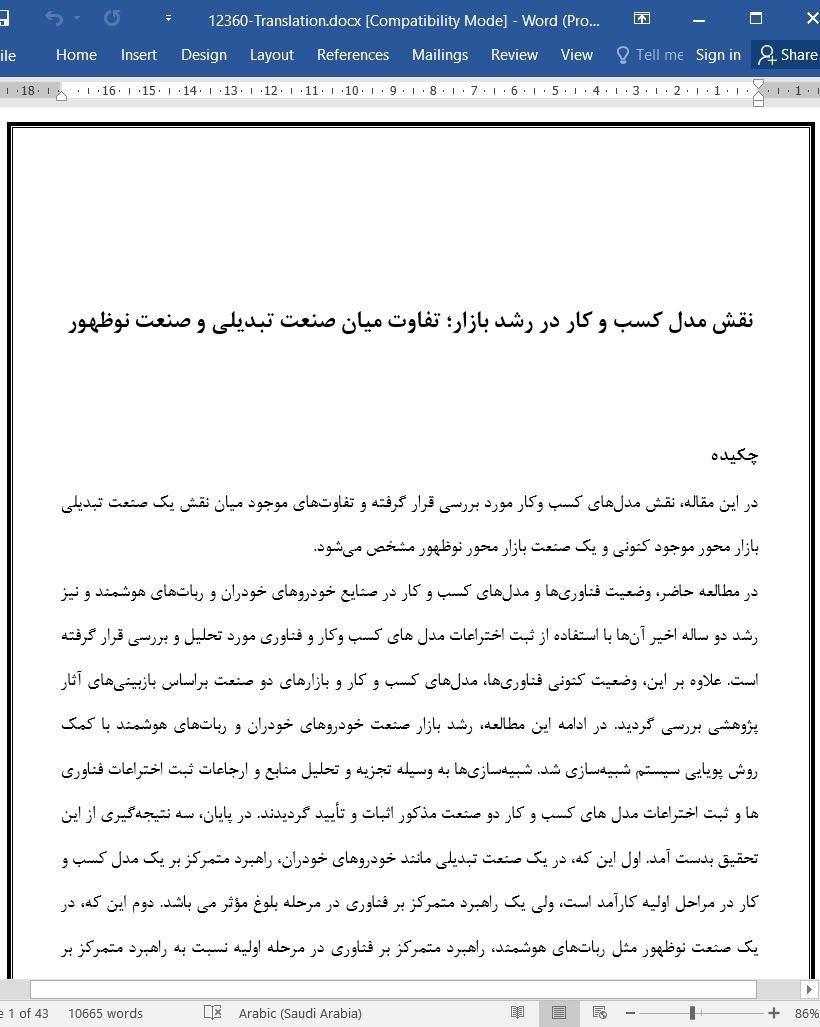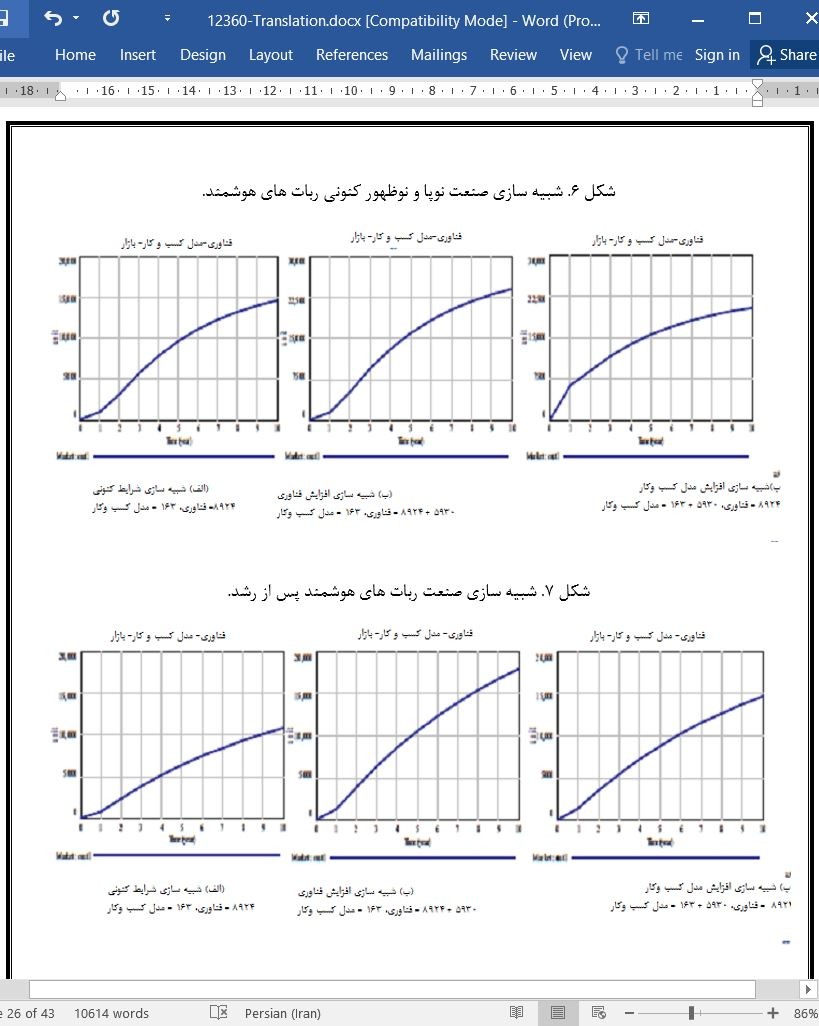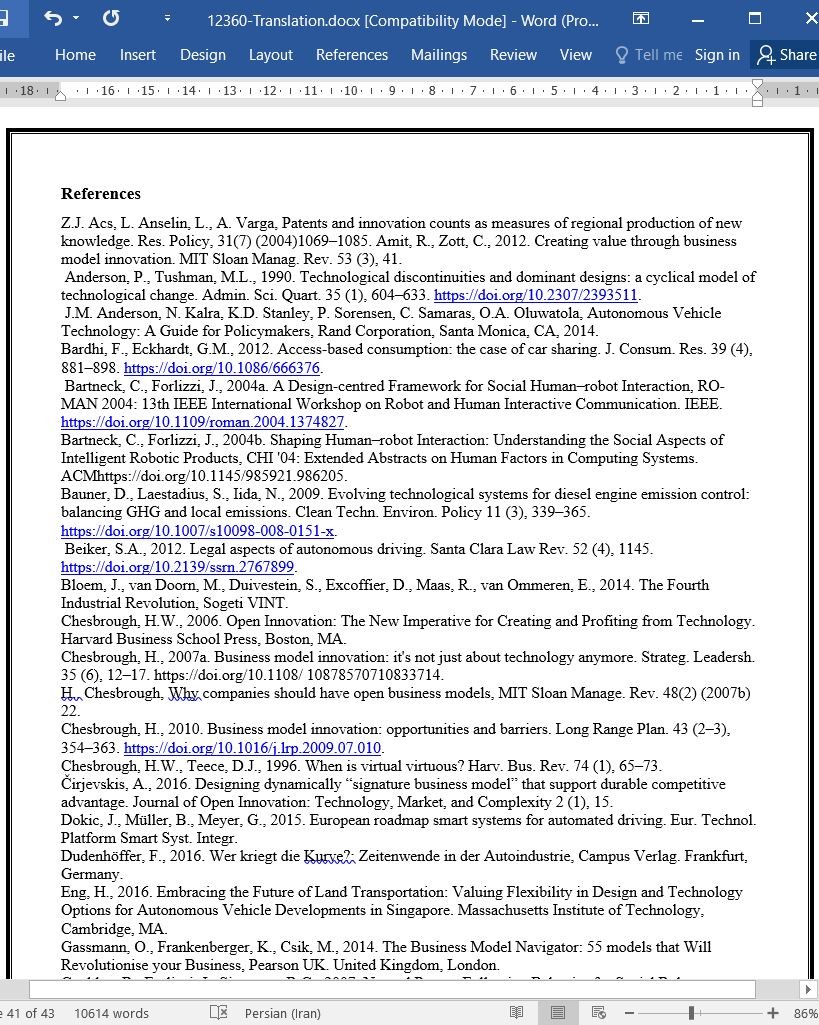
نقش مدل کسب و کار در رشد بازار؛ تفاوت میان صنعت تبدیلی و صنعت نوظهور
چکیده
در این مقاله، نقش مدلهای کسب وکار مورد بررسی قرار گرفته و تفاوتهای موجود میان نقش یک صنعت تبدیلی بازار محور موجود کنونی و یک صنعت بازار محور نوظهور مشخص میشود.
در مطالعه حاضر، وضعیت فناوریها و مدلهای کسب و کار در صنایع خودروهای خودران و رباتهای هوشمند و نیز رشد دو ساله اخیر آنها با استفاده از ثبت اختراعات مدل های کسب وکار و فناوری مورد تحلیل و بررسی قرار گرفته است. علاوه بر این، وضعیت کنونی فناوریها، مدلهای کسب و کار و بازارهای دو صنعت براساس بازبینیهای آثار پژوهشی بررسی گردید. در ادامه این مطالعه، رشد بازار صنعت خودروهای خودران و رباتهای هوشمند با کمک روش پویایی سیستم شبیهسازی شد. شبیهسازیها به وسیله تجزیه و تحلیل منابع و ارجاعات ثبت اختراعات فناوری ها و ثبت اختراعات مدل های کسب و کار دو صنعت مذکور اثبات و تأیید گردیدند. در پایان، سه نتیجهگیری از این تحقیق بدست آمد. اول این که، در یک صنعت تبدیلی مانند خودروهای خودران، راهبرد متمرکز بر یک مدل کسب و کار در مراحل اولیه کارآمد است، ولی یک راهبرد متمرکز بر فناوری در مرحله بلوغ مؤثر می باشد. دوم این که، در یک صنعت نوظهور مثل رباتهای هوشمند، راهبرد متمرکز بر فناوری در مرحله اولیه نسبت به راهبرد متمرکز بر یک مدل کسب و کار تاحدی مؤثرتر واقع میشود؛ برعکس، یک راهبرد متمرکز بر فناوری در مرحله بلوغ تا حدودی کارآمدتر است. سوم اینکه ، یک مدل کسب و کار برای تکمیل فناوری هایی مانند رباتهای هوشمند در مرحله بلوغ در کانادا یا خودروهای خودران در مرحله بلوغ در ژاپن نیز حایز اهمیت است .
1.مقدمه
پیشرفتهای فناوری اطلاعات در حال ایجاد تغییرات نوآورانه در همه صنایع است و به آنچه که خیلیها آن را انقلاب صنعتی چهارم نامیدهاند، منجر شده است. همزمان با شتاب گرفتن سرعت این تغییرات، ترکیبات خلاقانه فناوریها و بازارها نیز در بخشهای گوناگون اقتصاد در حال شکل گیری است .انتظار میرود که انقلاب صنعتی چهارم همزمان با شروع اتخاذ سیستمهای سایبری – فیزیکی که ترکیبی از سیستمهای فیزیکی و سیستمهای سایبری هستند، تغییرات انقلابی را توسط صنایع و بنگاههای کسب و کار ایجاد کند (بلوئم و همکاران، 2014). سیستمهای سایبری - فیزیکی (CPS) بر مبنای جدیدترین و قابل پیش بینیترین پیشرفتهای صورت گرفته در زمینه علوم کامپیوتر، اطلاعات و فناوریهای ارتباطی توأم با تولید علم و فناوری قرار دارند. مرز این تلاقی بارها در انقلاب صنعتی چهارم مشخص شده است (مونوستوری، 2014).
5.2.2. دستور کار تحقیقاتی آینده
ابتدا مشخص کردیم که توسعه راهبردهای نوآوری باز و مدلهای کسب و کار و هم چنین توسعه و نوآوری فناوری های شرکت های پیشرو در صنایع خودروهای خودران و ربات های هوشمند باید به دقت مورد تجزیه و تحلیل قرار گیرند. تحلیل دقیق واقعیتهای عملی نوآوری فناوری و توسعه مدل کسب و کار در یک صنعت تبدیلی و صنعت نوظهور به غنا بخشی و بسط مفاهیم این مطالعه کمک خواهد کرد.
دوم این که باید تجزیه و تحلیل آماری از طریق یک نظرسنجی گسترده برای تقویت محتوا و مفاهیم نتایج تحقیق حاضر انجام شود و شرکت های سازنده خودروی خودران و ربات های هوشمند، بازار آنها و جمع آوری اطلاعات فنی و سایر منابع مدنظر قرار گیرد.
Abstract
This paper investigates the role of business models: What differences exist between the roles of an already-existing market-based converted industry and a newly appearing market-based emerging industry?
This study analyzed the status of the technologies and business models in the autonomous car and intelligent robot industries, as well as their recent two-year growth, using technology and business model patents. In addition, it investigated the current situation of the technologies, business models, and markets of the two industries based on literature reviews. This study then simulated the market growth of the autonomous car and intelligent robot industries using system dynamics. The simulations were established and verified by analyzing the references and citations of the technology patents and business model patents of the two industries. This study reached three conclusions. First, in the case of a converted industry such as autonomous cars, a strategy focused on a business model is useful in the early stage, whereas one focused on technology is efficient in the mature stage. Second, in the case of an emerging industry such as intelligent robots, a strategy focused on technology is somewhat more useful in the early stage than one focused on a business model; conversely, a strategy focused on technology is slightly more useful in the mature stage. Third, a business model is also important to supplement technology such as intelligent robots at a mature stage in Canada or autonomous cars at a mature stage in Japan.
1. Introduction
IT advances are producing innovative changes in all industries, leading to what many have called the Fourth Industrial Revolution. As the pace of these changes accelerates, creative combinations of technologies and markets are emerging in various segments of the economy. This Fourth Industrial Revolution is expected to produce revolutionary changes as industries and businesses start to adopt cyber-physical systems, which are combinations of physical systems and cyber systems (Bloem et al., 2014). Cyber-physical systems (CPSs) are based on the newest and foreseeable developments in computer science, information, and communication technologies combined with manufacturing science and technology. This confluence is frequently designated Industry 4.0 (Monostori, 2014).
5.2.2. Future research agenda
First, we determined that the development of open innovation strategies and business models as well as the development and innovation of technologies of leading firms in the autonomous car and intelligent robot industries should be analyzed in depth. Detailed analyses of the practical realities of technology innovation and business model development in a converted industry and an emerging industry will enrich and broaden the implications of this study.
Second, a statistical analysis to enhance the content and implications of the present research results should be conducted through a massive survey, targeting autonomous car and intelligent robot companies, their market and technical data accumulation, and other sources.
چکیده
1.مقدمه
1.1. پرسش تحقیق
1.2. روش و حیطه تحقیق
2. مدلسازی پویایی سیستم
2.1. مرور آثار پژوهشی و مدل سازی پویایی سیستم
2.1.1. مرور آثار پژوهشی
2.1.2. مدل سازی
2.2. واقعیتهای دو صنعت
2.2.1. صنعت خودروهای خودران براساس مدل پویایی سیستم
2.2.2. صنعت ربات های هوشمند براساس مدل پویایی سیستم
3. شبیه سازی رشد بازار صنعت خودروهای خودران
3.1. شبیهسازی شرایط کنونی صنعت خودروهای خودران: شرکت پیشرو، ضعیف؛ استانداردسازی، ضعیف؛ و مقررات، قوی
3.2. شبیهسازی شرایط صنعت خودروهای خودران پس از رشد: شرکت پیشرو، قوی؛ استانداردسازی، قوی؛ و مقررات، قوی
4.رشد بازار صنعت رباتهای هوشمند
4.1. شبیهسازی شرایط کنونی صنعت ربات های هوشمند: شرکت پیشرو، قوی، استانداردسازی، ضعیف ؛ و مقررات، ضعی
4.2. شبیهسازی شرایط صنعت ربات های هوشمند پس از رشد: شرکت پیشرو، قوی؛ استانداردسازی، قوی، و مقررات، قوی
5. بحث و نتیجه گیری
5.1. بحث
5.1.1. نقش مؤثر مدل کسب و کار در یک صنعت تبدیلی
5.1.2. پسا همپایی از طریق نوآوری باز و توسعه مدل جدید کسب و کار
5.2. خلاصه و حدود و نیز دستور کار تحقیقاتی آینده
5.2.1. خلاصه و حدود
5.2.2. دستور کار تحقیقاتی آینده
منابع
ABSTRACT
1. Introduction
1.1. Research question
1.2. Research method and scope
2. System dynamic modeling
2.1. Literature review and system dynamics model building
2.1.1. Literature review
2.1.2. Model building
2.2. Realities of the two industries
2.2.1. Autonomous car industry from the system dynamics model
2.2.2. Intelligent robot industry from the system dynamics model
3. Simulating autonomous car industry market growth
3.1. Simulation of current autonomous car industry conditions: leading, weak; standardization, weak; and regulation, strong
3.2. Simulation of after-growth autonomous car industry conditions: leading firm, strong; standardization, strong; and regulation, strong
4. Simulating market growth of the intelligent robot industry
4.1. Simulation of current intelligent robot industry conditions: leading firm, strong; standardization, weak; and regulation, weak
4.2. Simulation of after-growth intelligent robot industry conditions: leading firm, strong; standardization, strong; and regulation, strong
5. Discussion and conclusion
5.1. Discussion
5.1.1. The high role of the business model in a converted industry
5.1.2. Post-catch-up by open innovation and new business model development
5.2. Summary and limits, and future research agenda
5.2.1. Summary and limits
5.2.2. Future research agenda
References
- اصل مقاله انگلیسی با فرمت ورد (word) با قابلیت ویرایش
- ترجمه فارسی مقاله با فرمت ورد (word) با قابلیت ویرایش، بدون آرم سایت ای ترجمه
- ترجمه فارسی مقاله با فرمت pdf، بدون آرم سایت ای ترجمه



